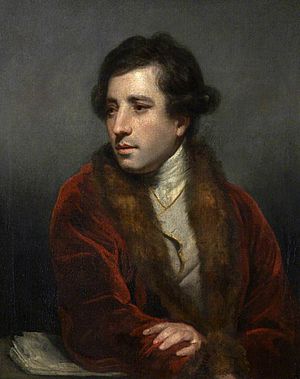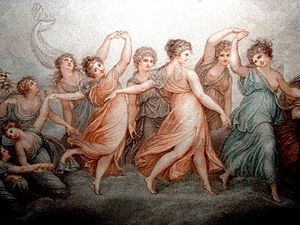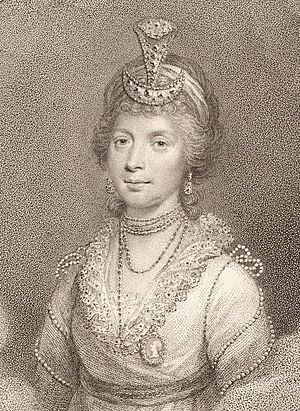Francesco Bartolozzi facts for kids
Quick facts for kids
Francesco Bartolozzi
|
|
|---|---|

Joshua Reynolds, Francesco Bartolozzi, 1773, Saltram House
|
|
| Born | 21 September 1727 Florence, Italy
|
| Died | 7 March 1815 (aged 87) Lisbon, Portugal
|
| Nationality | Italian |
| Education | Ignazio Hugford and Giovanni Domenico Ferretti |
| Known for | Engraving |
Francesco Bartolozzi (born September 21, 1727, in Florence, Italy – died March 7, 1815, in Lisbon, Portugal) was a famous Italian engraver. An engraver is an artist who creates pictures or designs by cutting lines into a hard surface, usually metal. Bartolozzi spent most of his working life in London, England. He became well-known for making the "crayon" method of engraving popular.
Early Life and Training
Francesco Bartolozzi was born in Florence in 1727. His father was a gold- and silver-smith, and Francesco was expected to follow in his footsteps. However, he showed a great talent for drawing and design. Because of this, he was sent to study with two Florentine artists, Ignazio Hugford and Giovanni Domenico Ferretti. They taught him how to paint.
After three years of painting, Bartolozzi moved to Venice. There, he began to study engraving. He worked for six years with Joseph Wagner, who was an engraver and sold prints. After this, Bartolozzi opened his own workshop.
Starting His Career
In Venice, Bartolozzi created his first engravings. These included works in the style of artists like Marco Ricci and Zuccarelli. In 1762, he moved to Rome for a short time. There, he finished a series of engravings that showed frescoes (wall paintings) by Domenichino. These paintings were about the life of St Nilus.
His engravings of these old masterworks started to get attention across Europe. In 1763, he met Richard Dalton. Dalton was the English Royal Librarian and was traveling in Italy to find art for the King's collections. Dalton offered Bartolozzi a job as the King's Engraver. Bartolozzi accepted and moved to London in 1764.

Working in London
Francesco Bartolozzi lived in London for almost 40 years. During this time, he created a huge number of engravings. Some famous ones include Clytie after Annibale Carracci, and a Virgin and Child after Carlo Dolci. Many of his works were based on paintings by his friends, Cipriani and Angelica Kauffman. Bartolozzi also made drawings of his own using red chalk.
Soon after arriving in London, he was named 'Engraver to the King' (George III). This job came with a yearly salary of £300. He was also chosen as a founding member of the Royal Academy. Even though the Academy's rules usually didn't include engravers, Bartolozzi was so respected that he was allowed in as an Academician in the painting category.
The Stipple Engraving Method
Bartolozzi became very skilled at a technique called "stipple engraving" (also known as the "crayon manner"). While he didn't invent it, he made it very popular. In this method, artists create images using many tiny dots instead of lines. This was different from older etching or engraving techniques. Bartolozzi often used red, orange, and brown inks, which made his prints stand out from the usual black ink.
As he became more famous, many students came to learn from him. His son, Gaetano Stefano Bartolozzi, born in 1757, also became an engraver. Gaetano's daughter, Madame Vestris, became a well-known English actress and singer.
Later Career in Lisbon
In 1802, Bartolozzi accepted a new job as the director of the National Academy of Lisbon, Portugal. He moved there hoping to improve the royal printing press and create a special edition of the Portuguese epic poem, The Lusiads. By this time, he was in his seventies, so he let one of his students do much of the work.
Even though he was famous and created many artworks, Bartolozzi faced financial problems. He had to sell most of his prints and belongings. Francesco Bartolozzi passed away in his studio in 1815 and was buried in a common grave in a Lisbon church.
Notable Works
Francesco Bartolozzi created a vast collection of engravings throughout his career. His works often featured detailed scenes and portraits.
Original Etchings
Some of the works he created from his own designs include:
- Abraham and the Angels
- The Miracle of the Manna
- Job abandoned by his Friends
- The Origin of Painting (1787)
Etchings After Other Artists
Bartolozzi also made many engravings based on the paintings of other famous artists. These included:
- Works after Annibale Carracci, such as Clytie.
- Scenes after Giovanni Battista Cipriani, like The Parting of Achilles and Briseis and The Death of Dido.
- Engravings after Angelica Kauffman, including Socrates in Prison and Coriolanus appeased by his Family.
- A series of 13 plates from the frescoes by Domenichino at Grottaferrata.
- A collection of 33 drawings by Guercino from the Royal Collection.
- Portraits after Hans Holbein the Younger, including Thomas More and Lady Meutas.
- The Death of Lord Chatham after John Singleton Copley.
- The Hours after Maria Cosway.
- Queen Charlotte after William Beechey.
See also
 In Spanish: Francesco Bartolozzi para niños
In Spanish: Francesco Bartolozzi para niños




